
Sargon is a line of chess-playing software for personal computers. The original SARGON from 1978 was written in assembly language by Dan and Kathleen "Kathe" Spracklen for the Z80-based Wavemate Jupiter III.

Time Traveler is a 1980 fantasy text adventure developed by Krell Software. The game was released on the 16K, Level II TRS-80, Apple II, Commodore PET, and Atari 8-bit family

Tycoon is a business simulation game for 1 to 5 players by David Bohlke for the TRS-80 Model I Level II and published by The Software Exchange.

FS1 Flight Simulator is a 1979 video game published by Sublogic for the Apple II. A TRS-80 version followed in 1980. FS1 Flight Simulator is a flight simulator in the cockpit of a slightly modernized Sopwith Camel. FS1 is the first in a line of simulations from Sublogic which, beginning in 1982, were also sold by Microsoft as Microsoft Flight Simulator.

Cosmic Patrol is a first-person space combat game programmed by Jake Commander for the TRS-80 Model I and III, published by Instant Software in 1980. In Cosmic Patrol the player pilots a one-man Terran fighter to destroy the invading Quelons. The game is very similar to the 1978 Magnavox Odyssey² cartridge Cosmic Conflict!.

Lost Dutchman's Gold is a 1979 video game designed by Terry Kepner and published by The Software Exchange for the TRS-80 16K.

Galaxy Invasion is a clone of Namco's Galaxian arcade game written by Big Five Software founders Bill Hogue and Jeff Konyu for the TRS-80 16K and published in 1980. It is the first game from Big Five to include sound and music. Galaxy Invasion was followed by an enhanced version in 1982, Galaxy Invasion Plus, which includes voice.
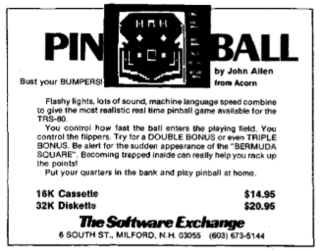
Pinball is a pinball simulation written by John Allen and published by Acorn Software Products in 1980 for the TRS-80.

Super Nova is clone of Atari, Inc.'s Asteroids arcade game published by Big Five Software for the TRS-80 in 1980. Co-author Bill Hogue called Super Nova "the game that started the company."

Parsector V is a 1980 video game published by Synergistic Solar for the TRS-80.
Stellar Adventure is a 1980 video game published by Software Innovations for the TRS-80.
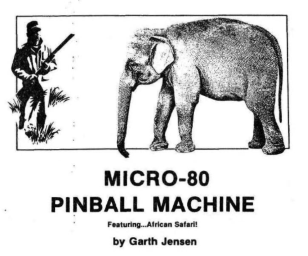
Micro-80 Pinball Machine is a 1980 video game published by Micro-80 Inc. for the TRS-80 16K. It was also published as a type-in BASIC listing in the July 1980 issue of SoftSide.
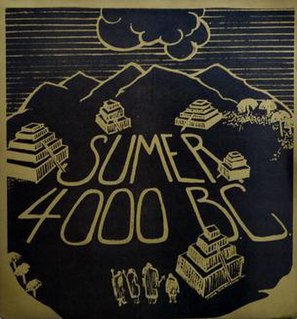
Sumer is a 1981 video game published by Crystal Computer for Apple II, Atari 8-bit family, Commodore PET, and TRS-80.
Monster Mash & Battleship is a 1980 video game published by Micro-80 Inc. for the TRS-80 16K.
Pork Barrel is a 1979 video game developed by George Blank and published by Ramware for the TRS-80.
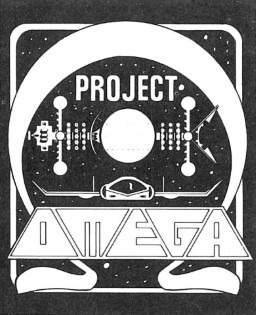
Project Omega is a 1980 video game published by Adventure International for the TRS-80.

Computer Acquire is a 1980 video game published by Avalon Hill for the Apple II, Atari 8-bit family, Commodore PET, and TRS-80. Computer Acquire is an adaptation of the board game Acquire that allows the player to play against the computer at five levels of difficulty.
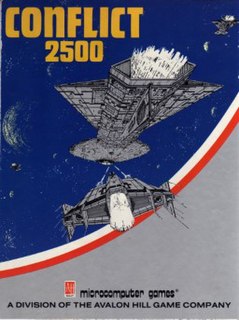
Conflict 2500 is video game published by Avalon Hill in 1981 for the Apple II, Atari 8-bit family, Commodore PET, and TRS-80.
Instant Software was a company that produced game, utility, and education software in the late 1970s and early 1980s primarily for the TRS-80 line of home computers. Instant Software was a subsidiary of Kilobaud Microcomputing, headquartered in Peterborough, New Hampshire and run by Wayne Green.
The Software Exchange was a company that produced computer games in the late 1970s and early 1980s, primarily for the TRS-80. It has origins with SoftSide magazine.















